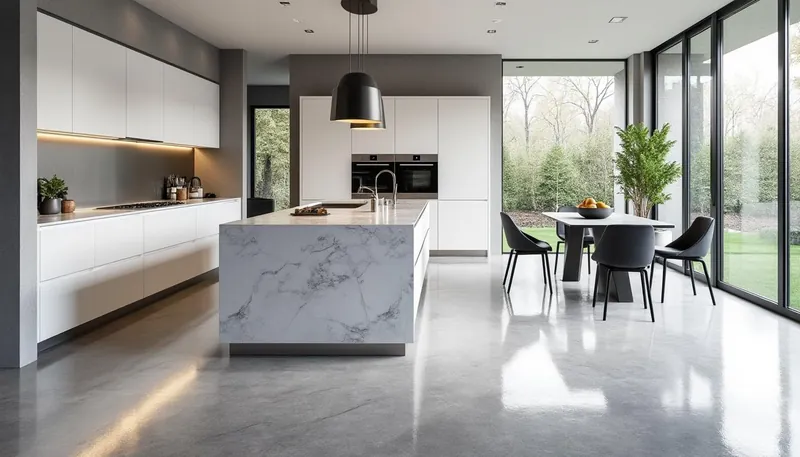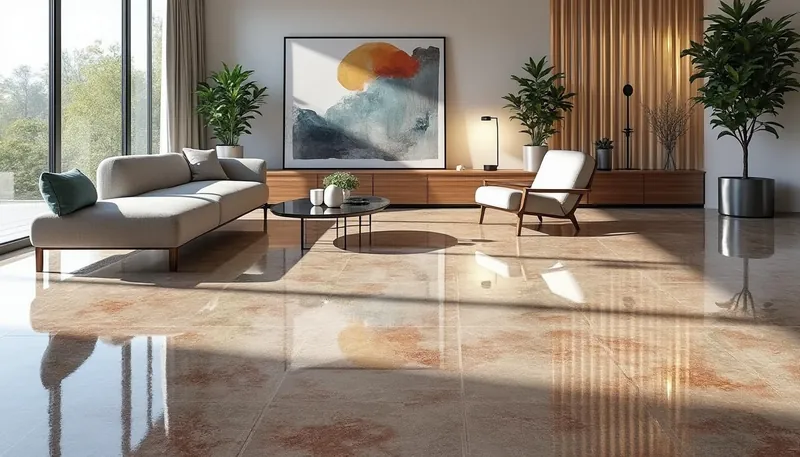When looking to upgrade your home flooring, you’ve probably encountered various choices—from classic hardwood to modern tiles and carpets. However, an option that’s gaining traction for its functionality and aesthetic appeal is epoxy flooring. Widely appreciated for its resilience and sleek appearance, epoxy has evolved from being a staple in industrial spaces to a stylish choice for home interiors. So, what’s all the buzz about? Let’s dive deeper into the world of epoxy flooring to understand why it might be the right choice for your home.
Brief
- 🎨 Epoxy flooring offers a polished, high-gloss finish that enhances any interior.
- 🛡️ Known for its exceptional durability, making it suitable for high-traffic areas.
- 💧 The non-porous surface is resistant to stains, moisture, and chemicals.
- 💰 Economical in the long run due to low maintenance and longevity.
- 🚧 Requires professional installation and can be slippery when wet.
Understanding Epoxy Flooring: What’s The Deal?
Epoxy flooring is essentially a combination of epoxy resin and a hardener. When these two components are mixed, they create a chemical reaction that produces a durable, glossy finish often used in commercial settings. The application process involves spreading this mixture onto a suited surface—be it concrete or even wood—resulting in a seamless and hard-wearing floor. Its rise in residential use is largely attributed to advances in formulation, making it a viable option for homeowners.
Some popular types of epoxy flooring include:
- 🔹 Solid Epoxy Floors: Commonly used for their minimalistic look and durability. They offer an eye-catching shine that can brighten any space.
- 🔹 Metallic Epoxy Floors: These feature unique designs with swirling patterns that lend a touch of luxury and sophistication to any room.
- 🔹 Flake Epoxy Floors: Decorative flakes or chips are embedded in the surface. This design choice adds texture and visual interest, accommodating various aesthetics.
The increasing adoption of epoxy in living areas such as kitchens and entryways shows its versatility. Homeowners are increasingly looking for unique aesthetics, and epoxy’s customizability with embedded color flakes or resin designs allows a plethora of creative expression. For instance, a metallic epoxy floor could seamlessly elevate a modern kitchen while ensuring practicality. When you think of epoxy flooring, it’s not merely a utilitarian choice—it’s a chance to accentuate your home’s visual narrative.

Where to Install Epoxy Flooring in Your Home
Given its many benefits, determining the best areas for installation is key. Epoxy flooring shines particularly in certain home zones:
- 🛠️ Garages: The durability of epoxy makes it suitable for protecting surfaces against oil spills, tire marks, and heavy objects.
- 🏠 Basements: Its moisture resistance keeps the floor dry and prevents mold, essential in areas prone to dampness.
- 🧺 Laundry Rooms and Workshops: The ability to handle chemical spills, heat, and heavy foot traffic makes epoxy a go-to option.
While some homeowners may shy away from using epoxy in living areas due to misconceptions, its applications extend far beyond utility. Epoxy floors are being used decoratively to craft an artistic statement while also providing practical benefits. Think about how sleek epoxy can transform a traditional living room into a contemporary masterpiece with just the right colors or designs!
The Pros of Epoxy Flooring: Why Choose It?
There are several compelling advantages that make epoxy flooring a worthy investment. Let’s break them down:
| Benefits | Description |
|---|---|
| 💪 Durability | Epoxy can withstand heavy foot traffic and impacts without wear and tear, making it ideal for busy families. |
| 🧹 Ease of Maintenance | Non-porous surfaces make cleaning simple—just sweeping and mopping will do. |
| ✨ Aesthetic Appeal | A customizable high-gloss finish reflects light, enhancing the overall aesthetic of your home. |
| 💰 Affordability | While initial costs can seem high, durability leads to long-term savings on maintenance and replacements. |
| 🏞️ Moisture Resistance | A non-porous design minimizes mold growth issues, especially in damp areas. |
One of the prime selling points of epoxy flooring is its remarkable durability. After curing, epoxy forms an extremely tough surface that resists dents, scratches, and even stains. This makes it a notable choice for garages and kitchens, given its shock-absorption abilities.
Another major advantage is ease of maintenance. With its smoothness, cleaning becomes a breeze—dirt and spills hardly stand a chance against a quick mop or sweep. This quality can significantly support a busy household where messes are a common occurrence. Who has time for intricate cleaning regimes? Not many.
Decoding Aesthetic Appeal and Customization
Beyond practicality, the aesthetic benefits of epoxy flooring should not be overlooked. You can personalize colors, patterns, and finishes to align seamlessly with your home’s design. Want a floor that mimics high-end marble without the exorbitant cost? Epoxy can do that! The glossy finish can elevate your living space, making it pop with modernity.
Customization options are endless. Companies like Rust-Oleum, Epoxy-Coat, and ArmorPoxy offer various aesthetic options, allowing homeowners to customize their floor to reflect personal styles. Whether it’s chic, modern, or rustic, finding an epoxy solution to fit your vision is undoubtedly achievable.
The Challenges of Epoxy Flooring: What to Consider
Of course, no flooring option is without its drawbacks. Here are some challenges associated with epoxy flooring that may need your attention:
| Drawbacks | Description |
|---|---|
| 🕒 Time-Intensive Installation | Preparation, multiple layers, and curing time can extend the project timeline. |
| ⚠️ Slippery When Wet | Can present safety issues, especially in households with children or elder residents. |
| 🧊 Cold and Hard | Feels cold underfoot and might require additional carpets or rugs for comfort. |
| 🔧 Limited Flexibility | Once installed, altering the design or color requires extensive work. |
Long installation times can be a deterrent for homeowners eager for a quick makeover. Preparing the substrate, applying multiple coatings, and allowing sufficient time for each layer to cure adds to the timeline. A professional installation crew from companies like Garage Living can mitigate this but may also increase labor costs.
Another concern is the slipperiness of epoxy when wet. Particularly in high-function areas such as bathrooms or kitchens, this can pose a safety hazard. To counteract this, consider anti-slip coatings available during installation, although these can add extra expenses.

Cracking and Repair Maintenance
Despite its durability, epoxy flooring can become cracked due to the shifting of the underlying layer or heavy impacts. These repairs might become time-consuming and can necessitate professional assistance. Having a well-prepared subfloor minimizes risks but doesn’t eliminate them entirely. This is an essential factor to consider before diving into the installation.
Finding the Right Contractor for Your Epoxy Flooring Needs
Selecting a quality epoxy flooring contractor can dramatically impact the outcome of your project. A proficient contractor ensures that the preparation work and installation are done correctly, minimizing future issues. Here are some tips to help navigate the contractor landscape:
- 🔍 Conduct online research to find specialized contractors in epoxy flooring.
- 📝 Check reviews on platforms like Angi or Find A Builder for community feedback.
- 📞 Request consultations and quotes from several contractors before making any decisions.
Asking for recommendations from friends and family can also lead you to trustworthy professionals with proven service records. During consultations, assess each contractor’s understanding of materials like Liquid Floors and Duraamen products, as well as their installation methodologies.
Considerations Before Committing
It’s crucial to communicate your expectations clearly, including desired timelines, costs, and potential disruptions. Establishing a good rapport will enable them to better understand your vision and guide you effectively. To help ensure everything runs smoothly, request to see past projects and client references. This step can give you peace of mind about the contractor’s capabilities.
What is the average lifespan of epoxy flooring?
Epoxy flooring can last 10 to 20 years, depending on installation quality and maintenance.
Is epoxy flooring suitable for outdoor use?
While epoxy can be used outdoors, UV-resistant coatings are necessary to prevent fading and yellowing.
Can I install epoxy flooring myself?
Installing epoxy flooring requires skill and knowledge; DIY may lead to issues like bubbles and uneven finishes.
Are there eco-friendly epoxy options available?
Yes, many brands like Leggari Products offer low-VOC formulations that are safer for the environment.
How do I clean and maintain my epoxy floor?
Regular sweeping and mopping with mild soap is recommended; avoid abrasive tools to maintain the shine.


